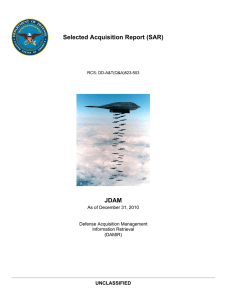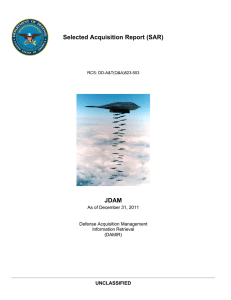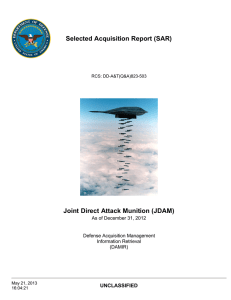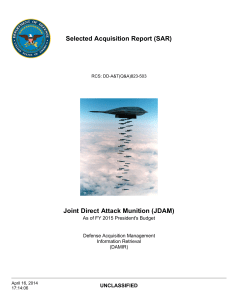Joint Direct Attack Munition (JDAM)
advertisement
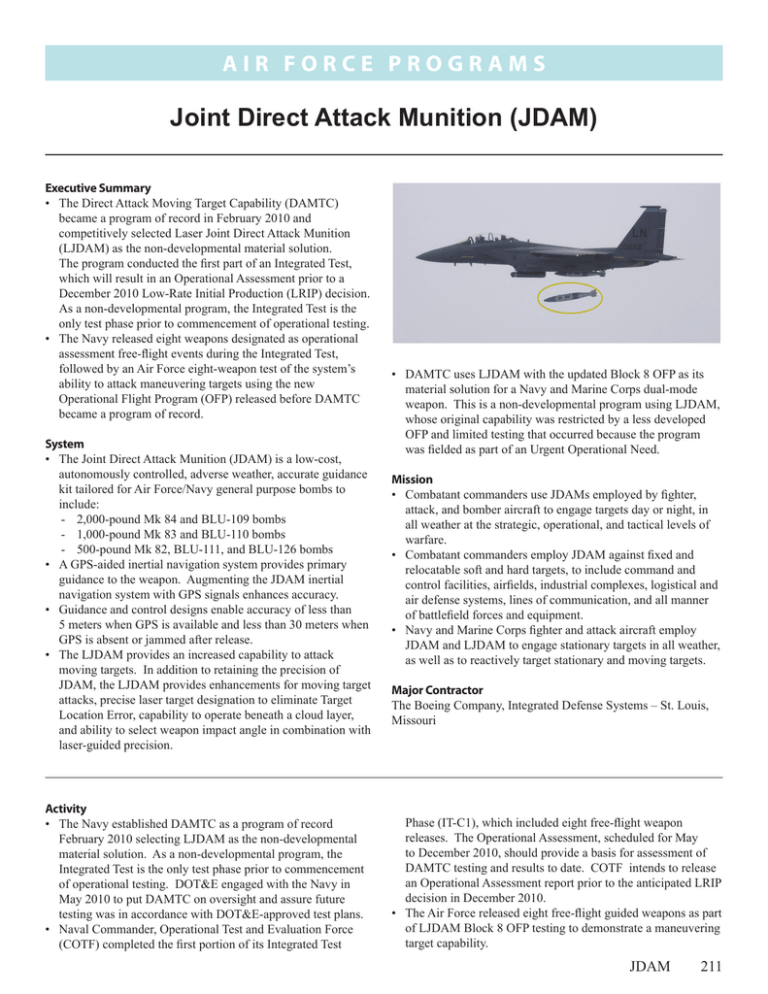
Ai r F o r c e P ROGRAMS Joint Direct Attack Munition (JDAM) Executive Summary • The Direct Attack Moving Target Capability (DAMTC) became a program of record in February 2010 and competitively selected Laser Joint Direct Attack Munition (LJDAM) as the non-developmental material solution. The program conducted the first part of an Integrated Test, which will result in an Operational Assessment prior to a December 2010 Low-Rate Initial Production (LRIP) decision. As a non-developmental program, the Integrated Test is the only test phase prior to commencement of operational testing. • The Navy released eight weapons designated as operational assessment free-flight events during the Integrated Test, followed by an Air Force eight-weapon test of the system’s ability to attack maneuvering targets using the new Operational Flight Program (OFP) released before DAMTC became a program of record. System • The Joint Direct Attack Munition (JDAM) is a low-cost, autonomously controlled, adverse weather, accurate guidance kit tailored for Air Force/Navy general purpose bombs to include: -­ 2,000-pound Mk 84 and BLU-109 bombs -­ 1,000-pound Mk 83 and BLU-110 bombs -­ 500-pound Mk 82, BLU-111, and BLU-126 bombs • A GPS-aided inertial navigation system provides primary guidance to the weapon. Augmenting the JDAM inertial navigation system with GPS signals enhances accuracy. • Guidance and control designs enable accuracy of less than 5 meters when GPS is available and less than 30 meters when GPS is absent or jammed after release. • The LJDAM provides an increased capability to attack moving targets. In addition to retaining the precision of JDAM, the LJDAM provides enhancements for moving target attacks, precise laser target designation to eliminate Target Location Error, capability to operate beneath a cloud layer, and ability to select weapon impact angle in combination with laser‑guided precision. Activity • The Navy established DAMTC as a program of record February 2010 selecting LJDAM as the non-developmental material solution. As a non-developmental program, the Integrated Test is the only test phase prior to commencement of operational testing. DOT&E engaged with the Navy in May 2010 to put DAMTC on oversight and assure future testing was in accordance with DOT&E-approved test plans. • Naval Commander, Operational Test and Evaluation Force (COTF) completed the first portion of its Integrated Test • DAMTC uses LJDAM with the updated Block 8 OFP as its material solution for a Navy and Marine Corps dual-mode weapon. This is a non-developmental program using LJDAM, whose original capability was restricted by a less developed OFP and limited testing that occurred because the program was fielded as part of an Urgent Operational Need. Mission • Combatant commanders use JDAMs employed by fighter, attack, and bomber aircraft to engage targets day or night, in all weather at the strategic, operational, and tactical levels of warfare. • Combatant commanders employ JDAM against fixed and relocatable soft and hard targets, to include command and control facilities, airfields, industrial complexes, logistical and air defense systems, lines of communication, and all manner of battlefield forces and equipment. • Navy and Marine Corps fighter and attack aircraft employ JDAM and LJDAM to engage stationary targets in all weather, as well as to reactively target stationary and moving targets. Major Contractor The Boeing Company, Integrated Defense Systems – St. Louis, Missouri Phase (IT-C1), which included eight free-flight weapon releases. The Operational Assessment, scheduled for May to December 2010, should provide a basis for assessment of DAMTC testing and results to date. COTF intends to release an Operational Assessment report prior to the anticipated LRIP decision in December 2010. • The Air Force released eight free-flight guided weapons as part of LJDAM Block 8 OFP testing to demonstrate a maneuvering target capability. JDAM 211 Ai r F o r c e P ROGRAMS • DOT&E and COTF, as well as Department of the Navy acquisition personnel, collaborated significantly to develop a Design of Experiments plan for the Operational Test Phase of DAMTC. An updated Test and Evaluation Master Plan is anticipated prior to the December LRIP decision. Assessment • Both the Air Force eight-weapon OFP test and the Navy’s eight weapons released during Integrated Test as part of the Operational Assessment indicate that the weapon has the potential to meet DAMTC requirements. • DAMTC’s preliminary results on six of eight weapons assessed so far demonstrate average miss distances within the threshold requirement of six meters with no major system shortfalls or performance deficiencies. 212 JDAM • Review of the current test strategy indicates a properly resourced program for both the Integrated Test and Operational Test Phases. Recommendations • Status of Previous Recommendations. The Navy is completing the FY08 recommendation by updating the Test and Evaluation Master Plan as a result of additional procurement and development of the LJDAM system. • FY10 Recommendation. 1. The Navy should closely monitor and allow adequate time to analyze the results of the remaining 10 Integrated Test weapons before initiating the Operational Testing Phase.






